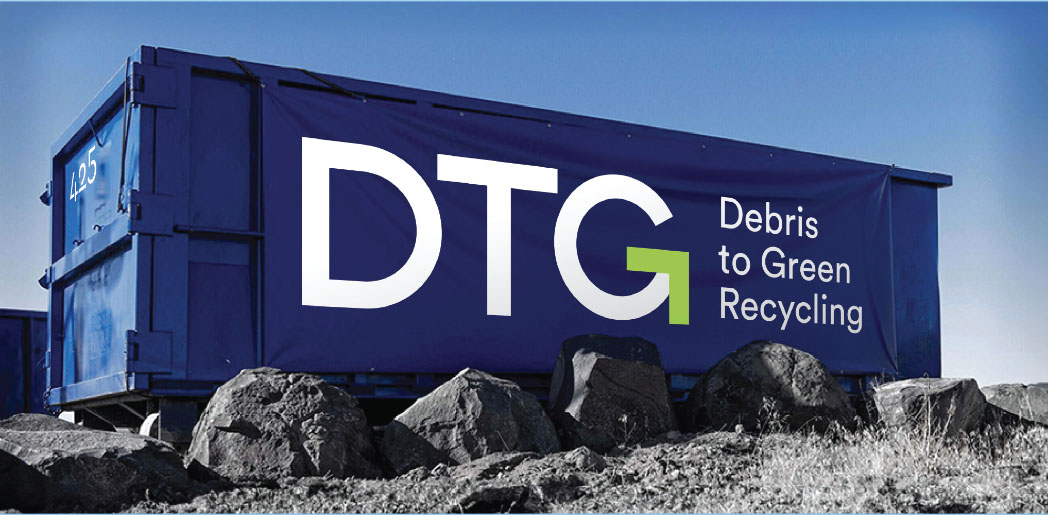Roofing Materials Recycling Center
Reliable Recycling Service for Your Roofing Shingles
At DTG Recycle, we utilize advanced sorting technologies to recognize and efficiently sort materials. DTG Recycle has Roofing Recycling Centers all over Washington State. You may also drop off your old roofing at our locations. Contact us for a price quote for roofing recycling.
As landfill availability diminishes and tipping fees rise, the importance of recycling becomes even more vital. We at DTG Recycle take pride in providing reliable debris management and roofing materials recycling services to take care of your roofing shingle and at the same time, preserve our environment.
Find out the proper way of roofing disposal, its recycling process, the types of recyclable roofing, and why you should repurpose them.
How to Dispose of Roofing for Recycling?
The proper way to dispose of old roofing for recycling depends on the recycling facility and local regulations. Some recycling facilities allow for drop-off of old roofing materials for recycling while some debris collection and removal services offer pickup of bulky or heavy roofing materials for recycling. Renting a dumpster for roofing disposal and collection can be an option. Lastly, you can get rid of old roofing materials at a landfill, but this should be a last resort if recycling is not an option as it contributes to landfill debris.
What Types of Roofing can be Recycled?
- Metal roofing: Steel, aluminum, copper, or zinc are just a few of the metals used to make metal roofing. It is strong and resilient and can be recycled to create new metal goods or materials.
- Asphalt shingle roofing: Asphalt shingle roofing is a common roofing material made from asphalt and fiberglass or organic materials. It can be recycled and repurposed into new shingles, road pavement, or other construction materials.
- EPDM roofing: The synthetic rubber roofing material EPDM (ethylene propylene diene terpolymer) is frequently utilized on commercial and industrial structures. It can be recycled and used to create brand-new roofing goods or supplies.
- Concrete or clay tile roofing: Concrete or clay tile roofing is a durable and long-lasting roofing material commonly used in residential and commercial buildings. It can be recycled and repurposed into new tiles or used as aggregate for road pavement or other construction materials.
It’s important to note that the recycling process can vary depending on the type of roofing material and the recycling facility. It’s also important to properly dispose of roofing materials that cannot be recycled to prevent environmental damage and comply with local regulations.
How is Roofing Recycling done?
The process of roofing recycling can vary depending on the type of roofing material and the recycling facility, but generally involves the collection, transportation, and processing of the materials. Here is a step-by-step guide on how it is done.
1. Collecting Roofing Shingles
The first step in roofing recycling is to collect the used shingles from the roofing project. This can involve setting up a designated area for collecting roofing shingles, separating the different types of materials, and keeping the them dry to prevent damage. Once the shingles have been collected, they can be transported to the recycling facility.
2. Sorting and Removing Contaminants
When the roofing shingle arrives at the recycling facility, it is sorted and inspected for contaminants such as nails, screws, or other debris. These contaminants must be removed before the materials can be processed.
After the initial sorting process, magnets are used to remove any metal contaminants. Then, air separators are used to remove lighter contaminants, such as wood or insulation fibers, from the roofing shingle. These separators use air flow to separate the lighter contaminants from the heavier roofing material.
3. Grinding
Once the roofing shingle has been sorted and any contaminants have been removed, the materials are ground up into smaller pieces using a grinding machine. This process can help to break down the materials and remove any remaining contaminants.
Generally, the roofing shingle is ground down into small pieces ranging from pea-sized to about 2 inches in diameter. Some manufacturers may require the recycled materials to be ground to a specific size, while others may be able to use a range of sizes.
4. Sizing
After the roofing materials have been ground up, they are sized to meet the specific requirements of the manufacturer. This can involve sorting the materials by size or using a screening process to remove any oversized or undersized pieces.
For asphalt shingle roofing, the size of the pieces resulting from primary grinding can vary based on the equipment used, with some yielding 2″ or 3″-minus sizes. Additional secondary grinding may be necessary to produce smaller pieces as required, such as 3/4″-minus for aggregate base or 1/2″-minus or 1/4″-minus for asphalt pavement.
5. Grading
The graded roofing materials are then inspected and graded based on their quality. Materials that meet the manufacturer’s requirements for quality and consistency are used in new products, while materials that do not meet these standards may be further processed or disposed of.
6. Transporting to Manufacturers
Once the roofing materials have been processed and graded, they are transported to manufacturers who use them to create new products. The materials can be used to create a variety of new products, such as roofing shingles, road pavement, or other construction materials.
Why Recycle Roofing?
Here are the reasons to recycle roofing shingles:
- Environmental sustainability
- Reduced landfill debris
- Cost savings compared to traditional disposal methods
- Preservation of natural resources
- Creation of jobs in the recycling industry
- Decreased demand for raw materials
- Contribution to LEED certification for green building projects
- Potential for tax incentives or credits for companies that recycle roofing shingles
- Positive public perception and reputation for companies that prioritize sustainability
Statistics on Roofing Recycling
234,000 residential roofs recycled into asphalt pavement
According to a NAPA survey conducted in 2020,1 the Asphalt Roofing Manufacturers Association (ARMA) estimates that 234,000 residential roofs were recycled into asphalt pavement. 2
Recycling shingle roof help pave 200 feet of a two-lane highway
Although shingle has been utilized in the past to pave roads, this only makes up 10% of the 13 million tons of roofing shingle produced annually. 3
The shingle roof of an average American home contains enough asphalt to help pave about 200 feet of a two-lane highway. One practical solution that could stop 11 million tons of roofing shingle from going to landfills is recycling asphalt shingles. 4
FAQs for Roofing Recycling Service
Where can I recycle roofing?
Roofing can be recycled at most recycling centers, as well as at curbside pickup programs in many areas. Check with your local recycling program for specific guidelines on how to recycle roofing in your area.
Can I make money by recycling roofing?
Some recycling programs offer cash or other incentives for recycling roofing. Additionally, businesses that generate large amounts of roofing can sell it to recycling companies, creating a source of revenue. However, the amount of money earned from recycling roofing varies depending on market conditions and other factors.
How many times can roofing be recycled?
The number of times roofing can be recycled depends on the type of roofing material.
- Asphalt shingles: Asphalt shingles can typically be recycled once, as the recycled material may not be suitable for use in new shingles due to degradation of the asphalt.
- Metal roofing: Metal roofing can be recycled multiple times without any significant loss of quality or performance.
- 1EPDM roofing: EPDM roofing can be recycled multiple times, although the material may lose some of its elasticity and other properties over time.
- Concrete or clay tile roofing: Concrete or clay tile roofing can also be recycled multiple times without any significant loss of quality or performance.
Can EPDM Roofing be recycled?
Yes, Ethylene Propylene Diene Terpolymer (EPDM) roofing can be recycled. EPDM is a type of synthetic rubber used in roofing membranes and it is a recyclable material. However, the recycling process for EPDM roofing can be more complicated than for some other roofing materials, such as metal, and it may require specialized equipment and processing methods.
Grinding and sizing techniques can be used to gather, sift, and reduce the size of EPDM roofing debris. The end product can be used to create new EPDM roofing materials, rubber playground surfaces, and other rubber goods, among other things. The original quality of the roofing material, the recycling process employed, and the intended application for the recycled material are just a few examples of the elements that will affect the quality and usability of the recycled material.
What can be made from recycled asphalt roofing?
The following can be made from recycled asphalt roofing shingles:
- Asphalt pavement: Asphalt pavement for roads, parking lots, and other applications can be made using recycled asphalt shingles (RAS). RAS can be used to replace virgin asphalt binder, lowering the demand for new raw materials and the price of asphalt production overall.
- Cold patch: For fixing potholes and other pavement damage, cold patch can also be made from recycled asphalt shingles. RAS, aggregate, and an emulsion are combined to create a cold patch, which can be used without heating.
- Roofing materials: Recycled asphalt shingles can be used to produce new roofing materials, such as asphalt shingles and roll roofing.
- Aggregate: Recycled asphalt shingles can be used as aggregate in concrete and other construction materials.
- Fuel: In some cases, recycled asphalt shingles can be used as a fuel source for industrial processes or for energy generation.
Can concrete or clay tile roofing be recycled?
Concrete and clay tiles are made from natural materials that can be crushed and recycled into new products. The recycling process involves collecting the used tiles, breaking them down into smaller pieces, and grinding them into granules. The resulting granules can be used as a base material in road construction, landscaping, or other applications that require durable, long-lasting materials.
Recycling roofing materials made of concrete or clay can help minimize debris and protect natural resources. It can also help you save money by giving you access to low-cost, high-quality building supplies. However, it’s important to keep in mind that recycling concrete or clay tiles can be more difficult than recycling some other types of roofing materials, and it may call for specific processing tools.
How much metal roofing is recyclable?
Metal roofing is highly recyclable, with most metal roofing materials being made from either steel or aluminum, which are both highly recyclable materials.
Up to 95% of roofing materials made of steel and aluminum are recyclable, according to industry estimates. 5 This means that with minimal debris, the vast majority of metal roofing may be collected, processed, and used to create new products.
Utilizing recycled material rather than virgin material can help reduce the quantity of debris that is dumped in landfills and save natural resources. As recycling metal uses less energy than mining and refining new metal, it may also result in energy savings.
References
1 Williams, Brett A., J. Richard Willis, and Joseph Shacat (National Asphalt Pavement Association, Greenbelt, MD), “Asphalt Pavement Industry Survey on Recycled Materials and Warm-Mix Asphalt Usage: 2020,” December 2021.
2 Estimate is based on assumption the shingles disposed during a typical single-layer roof replacement project weigh 2.5 pounds per square foot of roof area, and the average size of a typical roof is 2000 square feet.
3 With Landfills Filled With Old Roofing, Standard Industries’ GAF Debuts Recycled Shingles. Retrieved June 16, 2023, from https://www.forbes.com/sites/amyfeldman/2022/03/29/with-landfills-filled-with-old-roofing-standard-industries-gaf-debuts-recycled-shingles/
4 Roof-Recycling Statistics : recycled shingles. Retrieved June 16, 2023, from https://www.trendhunter.com/trends/recycled-shingles
5 The Environmental Benefits of Metal Roofing – The Architects Diary. Retrieved June 16, 2023, from https://thearchitectsdiary.com/the-environmental-benefits-of-metal-roofing/


